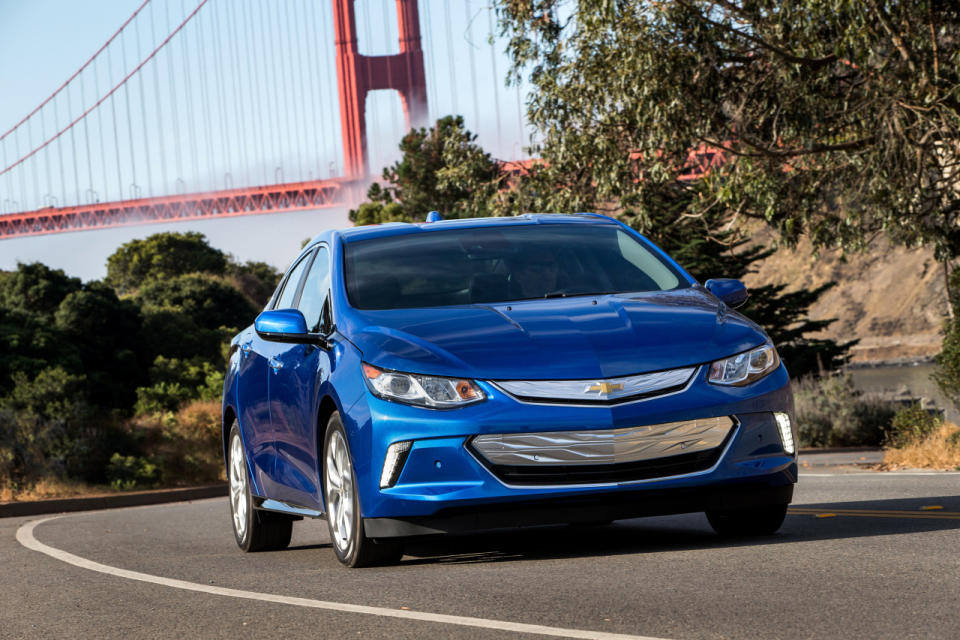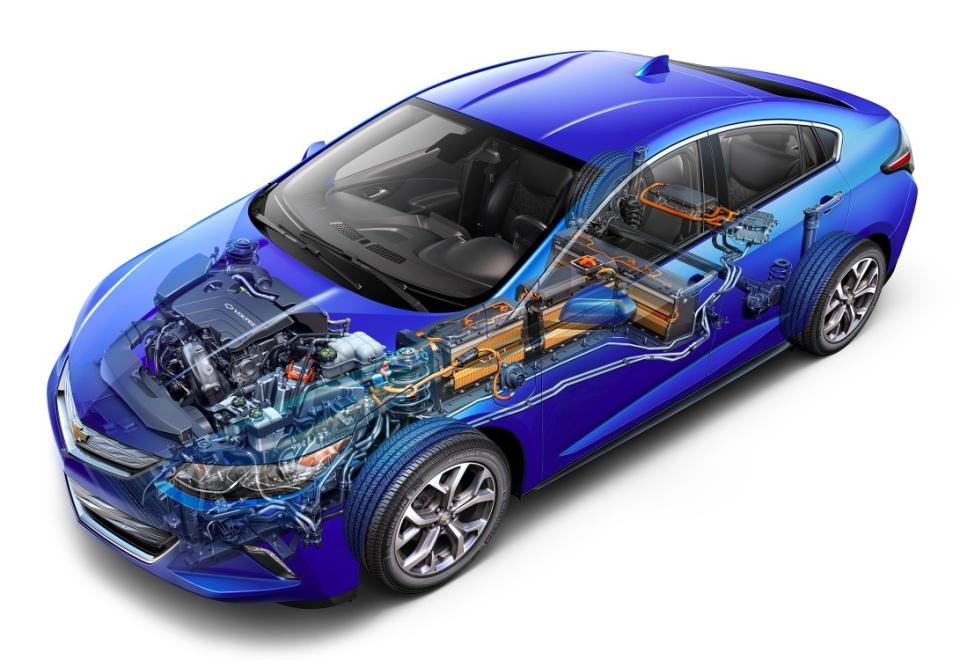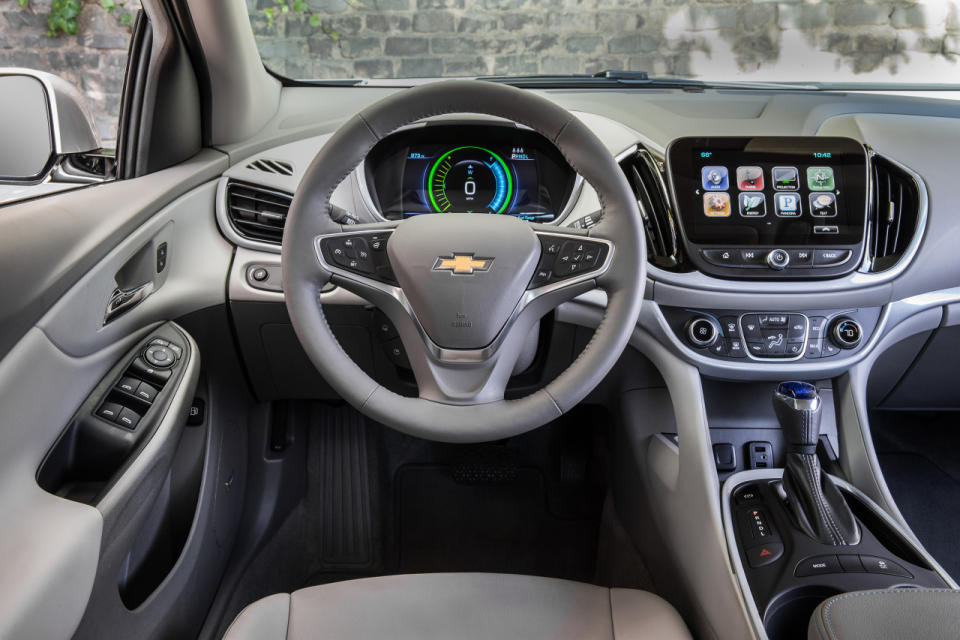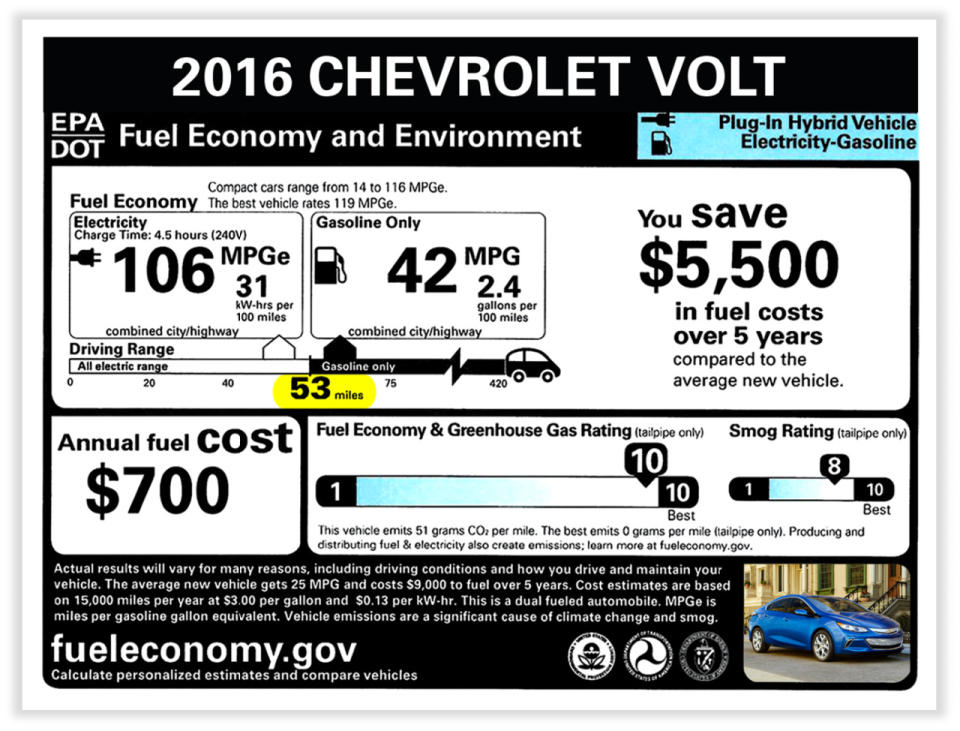Chevy Volt 2016: The Next-Generation Electric Car
In 2011, Chevrolet unveiled the Volt — the first electric vehicle to come out of Detroit in more than 10 years. Now, nearly 5 years later, the second-generation Volt is arriving at dealerships across the nation.
I got a chance to climb behind the wheel of the 2016 Chevy Volt and take it for a spin on the winding coastal roads north of San Francisco. The 2016 Volt won’t get your heart racing — this is not the Tesla Model S, let alone the Model X — but it’s a quiet, smooth, and comfortable ride, as well as a very practical one for people who hate spending time and money at the pump.

(All photos courtesy of GM)
As with the original Volt, this plug-in hybrid runs on electricity until the lithium-ion battery runs out of juice, and then a gasoline engine kicks in. What’s different about Volt 2.0 is when that happens. By improving the car’s energy efficiency, redesigning its lithium ion cells, making it more aerodynamic, and removing some weight, Chevy was able to squeeze out another 40 percent of power, boosting its emission-free range to more than 50 miles.
My co-pilot on the test drive, vehicle chief engineer Andrew Farah, says Chevy surveyed its army of 80,000 Volt owners extensively about how they use their cars. The upshot: They drive an average of 900 miles between stops at the pump. Farah believes the 2016 model will boost that number to more than 1,000 miles.
What’s new?
I hadn’t driven a Volt in a few years, but it immediately seemed roomier, and it is. Chevy has added 3 inches to the overall length to give backseat passengers a little more legroom.

But the biggest change is the longer-lasting battery. Instead of averaging 38 miles on battery power before it shifts over to gas, the new Volt can go up to 53 miles. Thanks to a clever redesign, the battery uses fewer lithium-ion cells and is 20 pounds lighter than the original.
The 2016 Volt takes slightly more time to recharge — 4.5 hours on the dedicated 220-volt charger and around 13 hours using standard household current. The battery is guaranteed to run for eight years or 100,000 miles, and if it doesn’t, Chevy will replace it free of charge (no pun intended).

Chevy has integrated the drive train, motors, and electronics into one package. It’s a thing of beauty. The Volt has swapped its original 1.4-liter iron block engine for a 1.5-liter aluminum one, increasing its size and power while reducing its weight. It now has two motors that work in sync to maximize torque and energy efficiency, while trimming the weight by another 100 pounds.
But this is no sports car. Chevy says the Volt goes from 0 to 60 in a respectable 8.4 seconds, about a half second faster than the original; still, you won’t be taking the 2016 Volt to your local drag strip and racing for pinks.
The Tesla Model S P85D with the Ludicrous Speed Upgrade covers the same distance in 2.8 seconds. Then again, that car costs $115,000. For that amount you could buy three Volts.
Display’s the thing
One of the coolest things about the original Volt was its animated internal displays, and the new model is even better. The LCD speedometer offers a choice of four looks; the in-dash infotainment system features an 8-inch touchscreen that works just like a tablet, so you can tap, pinch, and swipe to your heart’s delight.

As car infotainment systems go, the Chevrolet MyLink interface is better than most, with big easy-to-read icons for the audio system, phone, weather, navigation, and Pandora. The Volt also supports Apple CarPlay for owners of the iPhone 5 and later. Support for Android Auto is coming early next year, Farah says.
Related: Apple CarPlay Turns Your Auto Into an iPhone on Wheels
Interestingly, the new Volt sports some old-school manual HVAC controls that live below the infotainment system. The reason, says Farah: Volt owners told Chevy they hated fumbling through touchscreen menus to control the heat or crank the AC.

The Volt comes with three years of GM’s OnStar service and a 4G hotspot (wireless service not included). The OnStar RemoteLink app lets you open the car doors, start the car remotely, and see if it’s fully charged from your smartphone.
Like that of many new cars, the exterior of the Volt is studded with tiny cameras and proximity sensors. For a few dollars on top of the sticker price, you can add driverless car technology such as alerts for lane departure, rear cross-traffic, and forward collision; automatic braking if you get too close to the car in front of you; and semi-automatic parallel parking: Pull up next to an open space and the car’s computer will back it into place for you.
Things that make you go vroom
There are two reasons to buy the Volt. One is to save money, and the other is to save the earth.
The base model 2016 Volt LT lists for $33,170; the LTZ I drove runs $37,520. If you want cool driverless technology or the digital infotainment package, you can add another $500 to $1,500 to the price tag. That’s a bit more than most plug-ins, but the Volt can save you money in other ways.
According to the car’s Monroney sticker, the Volt can save an average driver $5,500 in fuel costs over five years, compared with your typical gas guzzler. Thanks to its carbon-saving properties, the Volt may also be eligible for a federal tax credit of up to $7,500, as well as state tax credits, depending on where you live and your tax situation. That can take some of the sting out of the nearly $40,000 sticker.

If you’re opposed to filling the atmosphere with more carbon, the Volt will also salve your conscience. According to the federal miles-per-gallon-equivalent (MPGe) standard, it offers a fuel efficiency rating of 106 miles when running on battery and 42 miles per gallon when on gas only. By contrast, the all-electric Nissan Leaf is rated at 126 MPGe but lacks the Volt’s gasoline backup. When the Leaf’s battery runs out of juice after 80 to 110 miles, so do you.
Charging the car will also add to your carbon footprint — especially if you live in the nearly 40 percent of the U.S. powered by coal-fired plants — but not nearly as much as running on gas. Farah estimates it costs from $1 to $2 in energy a night to recharge his personal Volt.
Even then, the Volt is not the best choice for someone who routinely drives more than 50 miles a day, unless you have charging stations at all your destinations. If you drive less, Volt gives you a (mostly) electric vehicle without the “range anxiety” some EV owners apparently suffer from or the hefty price tag of the Tesla.
And who knows? You might even get a charge out of driving one.
Editor’s note: This story was updated to include pricing for the base model Volt LT.
Read more about car tech at Yahoo Tech:
How Technology Helped Me Survive a 2,947-Mile Road Trip with 2 Teenagers and a Dog
Your Car May Be Programmed to Kill You — and 9 More Fun Facts About Self-Driving Vehicles
Send email to Dan Tynan here and follow him on Twitter.

